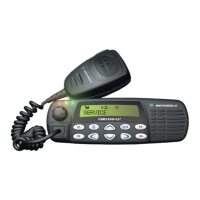2-24
Theory
of
Operation
The operating point
of
external RX VCO buffer Q3301 is stabilized
by
current mirror Q3302 which
adjusts Q3301's base current to maintain its collector current constant.
03301-2
are enabled by a
high at U3301 pin
7,
via transistor switches
Q331
0-11.
In
the TX mode, the modulation signal
(VCOMOD) from the LVFRAC-N synthesizer
IC
(U3201 pin 41) is applied to varactor diode D3362,
which modulates the TX VCO frequency via capacitor C3362. Varactor D3362 is biased for linearity
from the VSF via R3363.
2.6.4 Synthesizer Operation
The complete synthesizer subsystem consists
of
the low voltage FRAC-N (LVFRACN), reference
oscillator (a crystal oscillator with temperature compensation), charge pump circuit, loop filter circuit
and a de supply. The output signal PRESC from the VCOBIC (U3301 pin 12) is
fed
to U3201 pin
32
(PREIN) via a low pass filter (C3318, L3318 and C3226) which attenuates harmonics and provides
the correct
level to close the synthesizer loop.
The pre-scaler
in
the synthesizer (U3201)
is
a dual modulus type with selectable divider ratios. The
divider ratio
of
the pre-scaler is controlled by the loop divider, which
in
turn receives its inputs via the
SRL. The output
of
the pre-scaler is applied to the loop divider. The output
of
the loop divider
is
connected to the phase detector, which compares the loop divider's output signal with the reference
signal. The reference signal
is
generated by dividing down the signal
of
reference oscillator Y3263.
The output signal
of
the phase detector is a pulsed de signal which
is
routed to the charge pump.
The charge pump outputs a current at U3201 pin 43 (lOUT). The loop filter (which consists
of
R3221-R3223, R3343, C3221-C3224, and C3346) transforms this current into a voltage that is
applied to the varactor diodes (D3361 for transmit, D3341 for receive) to alter the output frequency
of
the appropriate VCO. The current can be set to a value fixed within the LVFRAC-N
IC,
or to a
value determined by the currents flowing into BIAS 1 (U3201-40) or BIAS 2 (U3201-39). The
currents are set by the value
of
R3251 and R3252 respectively. The selection
of
the three different
bias sources
is
done by software programming.
To
reduce synthesizer lock time when new frequency data has been loaded into the synthesizer, the
magnitude of the loop current is increased by enabling the IADAPT pin (U3201-45) for a certain
software programmable time (adapt mode). The adapt mode timer is started by a low to high
transient
of
the CSX line. When the synthesizer
is
within the lock range, the current
is
determined
only by the resistors connected to BIAS 1 and BIAS
2,
or by the internal current source. A settled
synthesizer loop is indicated by a high level signal at U3201-4 (LOCK).
The LOCK signal is routed to one
of
the
1-1P's
ADC inputs (U0101-56). From the measured voltage,
the
IJP
determines whether LOCK
is
active.
To
modulate the PLL, the two spot modulation method is utilized. Via U3201 , pin 10 (MODIN), the
audio signal is applied
to
both the AID converter (low frequency path) as well as the balance
attenuator (high frequency path). The AID converter changes the low frequency analog modulating
signal into a digital code that
is
applied to the loop divider, thereby causing the carrier to deviate.
The balance attenuator is used to adjust the VCO's deviation sensitivity to high frequency
modulating signals. The output of the balance attenuator
is
present at the MODOUT port (U3201-
41) and connected to the VCO modulation diode D3362 via R3364.
- ·

